Casting Processes
Angeheftet an
131
1
0
Keine Merkmale angegeben
|
|
Erstellt von Marissa Gotsell
vor fast 10 Jahre
|
|
Schließen
|
|
Erstellt von Marissa Gotsell
vor fast 10 Jahre
|
|

Solidification involves change of _____ of the metal.
Mould determines the ______ of the casting part.
Expendable moulds are made from:
Sand
Plaster
Ceramic shell
Metal
Permanent moulds are made from:
Sand,
Plaster
Ceramic shell
Metal
Parting line separates:
- The cast and the mould.
- The mould and the flask.
- The cope and the drag halves of the mould.
- The feeder from the casting.
The upper part of a mould:
Cope or Drag
The bottom half of a mould:
Cope or Drag
The two mould parts are contained in a box called a _____ .
In sand casting, the mould cavity if formed by using:
- a pattern that has the same shape as the part to be cast.
- a pattern made up of wax.
- compacted sand containing a binder.
- ceramic.
Cores are:
- used to pour molten metal into the mould.
- used to supply the molten metal to all parts of the mould.
- provided ti render additional strength to the mould.
- forms places inside the mould cavity to define the interior geometry of the part.
The grating system can be defined as:
A riser acts as a:
The gating system and riser design do not influence the solidification pattern in casting:
True or False
The riser should ideally freeze/solidify:
- at the same time as main casting.
- before the casting.
- after the casting has solidified.
- at the beginning of the solidification process.
Riser should ideally be located at the thinnest sections of the casting:
True or False
Size, shape, number and location of the risers depends on the dimensions and geometry of the casting:
True or False
Why are b and d correct designs of castings and riser locations?
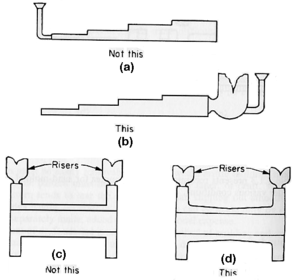
As the pouring of molten metal starts, the air and gasses occupying the mould cavity should be:
A typical mixture for green sand mould is:
__ % sand, __ % water and __ % clay.
Four main indicators of a good quality sand mould are:
-strength
- impermeability
- collapsibility
- permeability
- thermal stability
- conductivity
Which of the following provide better dimensional control?
- green-sand moulds
- dry-sand moulds
- skin-dried moulds
- no-bake moulds
Shell moulds:
- are weak moulds.
- are used to make ammunition shells.
- provide better surface finish and dimensional accuracy.
- are made up of sand held together by thermosetting resin binders.
In Investment Casting:
- a pattern made of wax is coated with a refractory material to make the mould.
- the wax is retained till the completion of the solidification inside the mould.
- the wax is melted and extracted from the mould prior to casting.
- a permanent metal mould is used.
Investment casting is also known as:
- stolen-wax process
- filled-wax process
- lost-wax process
- no-wax process
What is being poured in this step?

Die casting process:
- uses an expendable plaster mould.
- uses a permanent mould.
- does not require a mould.
- uses a sand mould.
In die casting, the mould is made up of:
Which casting process is shown below?
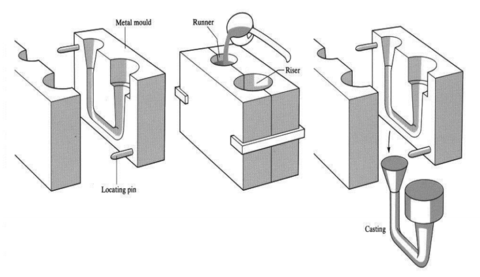
The shaped die to produce parts with a complex shape constitute ____ die forging.
Molten metal is forced into a water cooled metal mould through a system of sprues and runners in pressure die casting:
True or False
When dies are at the same temperature as the work metal piece, the forging process is known as:
Which of these for Squeeze Casting are true?
- this process can be used to reduce porosity in casting.
- metal utilisation is rarely better than 50%
- metal utilisation can be as high as 100%
- the mould is pre heated
This casting process is known as ___ casting and can be used to reduce porosity in casting.

This casting process which provides a cost-effective method for producing hollow cylindrical parts and circular plates is:
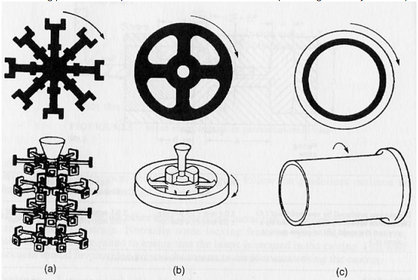
In case of centrifugal casting, the mould is rotated along its long axis to distribute metal over the inner surface.
True or False
Which of these are casting defects?
insufficient venting, cold shuts, shrinkage cavity, oxidised melt, microporosity, misrun, cold shots, snapping, hot tearing, cracked mould.
Casting defect misrun is often caused by:
Casting defect such as shrinkage cavity can often be solved by a proper riser design.
True or False
Metals used in manufacturing are usually alloys, composed of two or more elements, at least one of which is a metallic element.
What two basic groups can metals be divided into?
Three categories of processing operations:
The 4 Shaping Processes Classifications:
Particulate Processing:
Deformation Processes:
Material Removal Processes:
Casting is:
Disadvantages associated with casting include:
The actual size and shape of the cavity must be designed slightly _____ to allow for shrinkage that occurs in the metal during solidification and cooling.
Moulds can be made from:
The two types of moulds are open moulds and _____ moulds.
In a closed mould a passageway, called a ____ system, is provided to permit the molten metal to flow from the outside world into the cavity.
An ______ mould in casting means that the mould in which molten metal solidifies must be destroyed in order to remove the casting.
A ______ mould is one that can be used over and over to produce many castings. The mould consists of of two (or more) sections that can be opened to permit removal of the finished part. Die casting is the most familiar process.
More intricate casting geometries are generally possible with the ______ mould process.
Past shapes in the permanent mould process are limited by:
Some ______ mould processes have certain economic advantages in high-production operations.
Selection of the appropriate pattern material in Sand Casting depends to a large extent on:
3 types of Sand Casting patterns include:
The simplest sand casting pattern is made of one piece, called a solid pattern with the same geometry as the casting, adjusted in size for shrinkage and machining. These patterns are generally limited to very low production quantities because:
____ patterns (sand casting) consists of two pieces, diving the part along a plane coinciding with the parting line of the mould.
Split patterns (sand casting) are appropriate for ___________ and ____________ .
Foundry sands are:
Sand should possess good refractory properties, meaning:
Important features of the sand in sand casting include:
Small grains of sand in sand casting provides better surface finish on the cast part but large grain size is more _____ .
In sand casting, moulds made from irregular shape tend to be stronger than moulds of round grains because of interlocking, yet interlocking tends to restrict ______ .
5 indicators used to determine the quality of the sand mould are:
Greensand moulds advantages and disadvantages:
Dry-sand moulds are made using organic binders rather than clay and the mould is then baked. The mould is baked because it:
Dry-sand mould provides better ________ control in the cast product compared to greensand moulding.
Disadvantages of dry-sand moulding are:
Skin-dried moulds are achieved by:
No-bake systems include furan resins, phenolics and alkyd oils. They are growing in popularity due to their:
Advantages of Shell moulding:
Disadvantage of Shell moulding:
Advantages of Investment casting:
In investment casting in high-production operations, several patterns are attached to a sprue, also made of wax, to form a _________ .
Investment casting - coating with refractory is usually accomplished by:
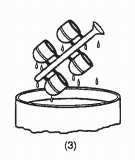
Advantages of Investment casting:
Disadvantage of Investment casting:
Gravity die casting has a short cycle time since:
Gravity die casting's materials utilisation is rarely better than __ % but runners and risers can often be remelted.
Pressure die casting is when:
In pressure die casting the metal needs to be of a high ____ and low melting point eutectic alloys are usually used.
The operation costs are high since both the _______ and ____ are expensive.
Squeeze casting reduces:
Squeeze casting is where:
In squeeze casting, provided metering is good the metal utilisation can approach ___ % .
Centrifugal casting is a ______ mould process where the mould may be either of the sand or metal variety.
Object of centrifugal casting is to product relatively long hollow objects without the use of ___ .
In centrifugal casting the mould is rotated about its ___ axis thus distributing the metal over the inner surface.
The absence of sprues and runners in centrifugal casting means that its metal utilisation is close to ___ % .
Casting defect misrun is:
Casting defect cold shut occurs when:
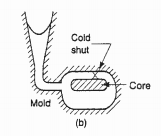
Casting defect cold shots are:
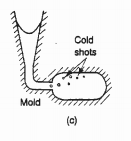
Casting defect shrinkage cavity is:
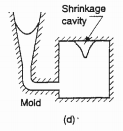
Casting defect microporosity refers to:
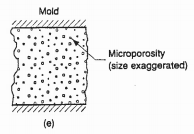
Casting defect hot tears (hot cracking) occurs:


 Verberge bekannte Karten
Verberge bekannte Karten